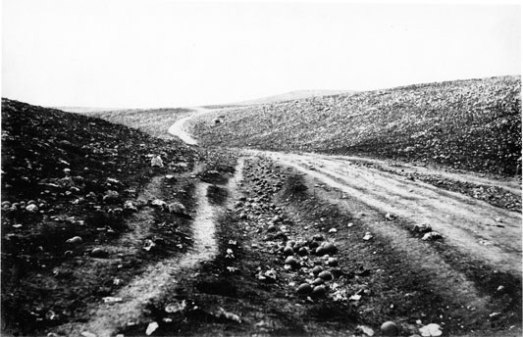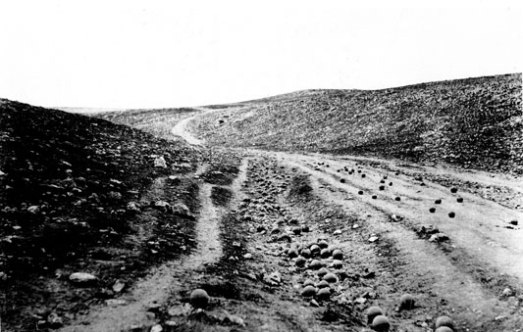
(1) Fenton, Roger. Valley of The Shadow of Death. Harry Ransom Humanities Research Center, The University of Texas at Austin.

(2) Fenton, Roger. Valley of The Shadow of Death. Harry Ransom Humanities Research Center, The University of Texas at Austin.
Nonfiction writers and readers are no strangers to the dialectic between those who think there is room in nonfiction for embellishment, and those who disapprove of any kind of fact-bending. At the heart of the debate seems to be a disagreement of what it means for a story to be true. Is a story true because its details can be supported by multiple sources? Or is it true because it accurately represents the experience of the writer? Must both these standards be met? And, if so, what’s a writer to do if facts and personal experience disagree?
Errol Morris’ three part article published by The New York Times back in 2007 discusses two photographs by Roger Fenton (pictured above). Some experts say that the first photograph (1) was taken before the second (2). The second, more renowned because of its emotionally provocative representation of the extreme violence of the Crimean War, is often discounted by experts as being staged by Fenton after the first photo didn’t produce the impact he desired. Though there is some disagreement about the order in which the photos were taken, it is intuitively more probable that Fenton arranged cannonballs on the road before taking the second shot, rather than removing the cannonballs between shots. What would be the purpose in that?
In the article “Which Came First, the Chicken or the Egg?” Morris sets out to prove which photograph came first. My central question is different: Assuming the second photograph was embellished by Fenton, is it less truthful than the first? According to Morris’ article, it is a known fact that the setting of the photos was a dangerous valley where cannonballs were flying around the clock. If Fenton manipulated the scene to more effectively highlight this very real characteristic of the location and its place in the war, maybe his embellishment is a means by which he infuses the photograph with more veracity, not falsity. Maybe the second is actually more truthful.
Can nonfiction, like photography, also be “truly embellished”? What do you think?








